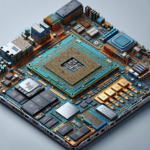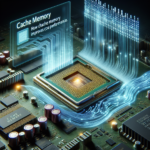Explaining the Impact of CPU Architecture on Mobile Devices

Explaining the Impact of CPU Architecture on Mobile Devices
In the rapidly evolving world of mobile technology, the Central Processing Unit (CPU) plays a pivotal role in determining the performance, efficiency, and capabilities of mobile devices. The architecture of a CPU, which refers to its design and operational principles, significantly impacts how a mobile device functions. This article delves into the intricacies of CPU architecture and its profound influence on mobile devices.
Understanding CPU Architecture
What is CPU Architecture?
CPU architecture refers to the design and organization of the core components of a CPU. It encompasses the instruction set architecture (ISA), microarchitecture, and the physical implementation of the CPU. The ISA defines the set of instructions that the CPU can execute, while the microarchitecture outlines how these instructions are processed. The physical implementation involves the actual manufacturing process and materials used to create the CPU.
Key Components of CPU Architecture
- Instruction Set Architecture (ISA): The ISA is a critical component that defines the commands a CPU can execute. Common ISAs in mobile devices include ARM, x86, and MIPS.
- Microarchitecture: This refers to the internal design of the CPU, including the arrangement of its cores, cache, and pipelines. It determines how efficiently the CPU can execute instructions.
- Core Count: Modern mobile CPUs often feature multiple cores, allowing for parallel processing and improved multitasking capabilities.
- Cache Memory: Cache is a small, high-speed memory located within the CPU that stores frequently accessed data, reducing the time needed to retrieve information from the main memory.
- Clock Speed: Measured in gigahertz (GHz), clock speed indicates how many cycles a CPU can perform per second. Higher clock speeds generally translate to faster processing.
The Evolution of Mobile CPU Architecture
Early Mobile CPUs
In the early days of mobile technology, CPUs were relatively simple and designed primarily for basic tasks such as making calls and sending text messages. These early CPUs had limited processing power and were not optimized for energy efficiency, leading to short battery life and limited functionality.
The Rise of ARM Architecture
ARM (Advanced RISC Machines) architecture revolutionized the mobile CPU landscape. ARM CPUs are based on a Reduced Instruction Set Computing (RISC) architecture, which simplifies the instruction set, allowing for more efficient processing and lower power consumption. This made ARM CPUs ideal for mobile devices, where energy efficiency is crucial.
Modern Mobile CPUs
Today, mobile CPUs are highly sophisticated and capable of handling complex tasks such as gaming, video editing, and artificial intelligence. Modern mobile CPUs often feature multiple cores, advanced microarchitectures, and integrated graphics processing units (GPUs). Companies like Qualcomm, Apple, and Samsung have developed powerful mobile CPUs that push the boundaries of what mobile devices can achieve.
Impact of CPU Architecture on Mobile Device Performance
Processing Power
The architecture of a CPU directly influences its processing power. A well-designed CPU architecture can execute instructions more efficiently, leading to faster performance. For example, ARM’s big.LITTLE architecture combines high-performance cores with energy-efficient cores, allowing for a balance between performance and power consumption.
Energy Efficiency
Energy efficiency is a critical factor in mobile devices, as it directly impacts battery life. CPUs with efficient architectures consume less power while delivering high performance. ARM’s RISC architecture, for instance, is known for its energy efficiency, making it a popular choice for mobile devices.
Multitasking and Parallel Processing
Modern mobile CPUs often feature multiple cores, enabling parallel processing and improved multitasking capabilities. This means that a mobile device can run multiple applications simultaneously without significant performance degradation. The architecture of the CPU determines how effectively it can manage and distribute tasks across its cores.
Thermal Management
Thermal management is crucial in mobile devices to prevent overheating and ensure consistent performance. Efficient CPU architectures generate less heat, reducing the need for complex cooling solutions. This is particularly important in thin and lightweight mobile devices where space for cooling components is limited.
Impact of CPU Architecture on Mobile Device Capabilities
Gaming and Graphics
Mobile gaming has become increasingly popular, and the CPU architecture plays a significant role in determining gaming performance. CPUs with integrated GPUs and advanced microarchitectures can handle complex graphics and provide a smooth gaming experience. For example, Apple’s A-series chips are known for their powerful GPU performance, making iPhones and iPads popular choices for mobile gaming.
Artificial Intelligence and Machine Learning
Artificial intelligence (AI) and machine learning (ML) are becoming integral parts of mobile devices, enabling features such as facial recognition, voice assistants, and real-time language translation. CPUs with specialized architectures, such as Apple’s Neural Engine or Qualcomm’s Hexagon DSP, are designed to accelerate AI and ML tasks, enhancing the capabilities of mobile devices.
Camera and Image Processing
Modern mobile devices are equipped with advanced cameras that rely on powerful CPUs for image processing. CPU architectures with dedicated image signal processors (ISPs) can handle tasks such as noise reduction, HDR processing, and real-time video stabilization, resulting in higher-quality photos and videos.
Connectivity and Communication
CPU architecture also impacts the connectivity and communication capabilities of mobile devices. Efficient architectures can handle complex communication protocols, such as 5G, Wi-Fi 6, and Bluetooth 5.0, ensuring fast and reliable connections. This is essential for activities such as video streaming, online gaming, and video conferencing.
Challenges and Future Trends in Mobile CPU Architecture
Challenges
- Heat Dissipation: As mobile CPUs become more powerful, managing heat dissipation becomes increasingly challenging. Efficient thermal management solutions are needed to prevent overheating and ensure consistent performance.
- Battery Life: Balancing performance and battery life is a constant challenge in mobile CPU design. While powerful CPUs can deliver exceptional performance, they can also drain the battery quickly.
- Manufacturing Complexity: Advanced CPU architectures require sophisticated manufacturing processes, which can be costly and complex. This can impact the overall cost of mobile devices.
Future Trends
- 5nm and Beyond: The semiconductor industry is continually pushing the boundaries of miniaturization. CPUs based on 5nm and smaller process nodes offer improved performance and energy efficiency.
- AI Integration: Future mobile CPUs will likely feature even more advanced AI and ML capabilities, enabling new applications and enhancing existing features.
- Quantum Computing: While still in its early stages, quantum computing has the potential to revolutionize mobile CPU architecture, offering unprecedented processing power and efficiency.
- Custom Architectures: Companies like Apple and Google are increasingly developing custom CPU architectures tailored to their specific needs, allowing for greater optimization and differentiation.
FAQ
What is the difference between ARM and x86 architecture?
ARM architecture is based on a Reduced Instruction Set Computing (RISC) design, which simplifies the instruction set for more efficient processing and lower power consumption. x86 architecture, on the other hand, is based on a Complex Instruction Set Computing (CISC) design, which includes a more extensive set of instructions. ARM is commonly used in mobile devices due to its energy efficiency, while x86 is often found in desktops and laptops.
How does CPU architecture affect battery life?
CPU architecture significantly impacts battery life by determining how efficiently the CPU processes instructions and manages power consumption. Efficient architectures, such as ARM’s RISC design, consume less power, leading to longer battery life in mobile devices.
Why are multiple cores important in mobile CPUs?
Multiple cores allow a CPU to perform parallel processing, enabling it to handle multiple tasks simultaneously. This improves multitasking capabilities and overall performance, making mobile devices more responsive and capable of running complex applications.
What role does the GPU play in mobile CPUs?
The GPU (Graphics Processing Unit) is responsible for rendering graphics and handling visual tasks. In mobile CPUs, integrated GPUs enhance gaming performance, support high-resolution displays, and accelerate tasks such as image processing and video playback.
How do custom CPU architectures benefit mobile devices?
Custom CPU architectures are designed to meet the specific needs of a company or device, allowing for greater optimization and differentiation. For example, Apple’s custom A-series chips are tailored to provide exceptional performance and energy efficiency for iPhones and iPads.
Conclusion
The architecture of a CPU is a fundamental factor that shapes the performance, efficiency, and capabilities of mobile devices. From early mobile CPUs to modern, sophisticated designs, advancements in CPU architecture have driven the evolution of mobile technology. As we look to the future, continued innovation in CPU architecture will unlock new possibilities and further enhance the mobile experience. Understanding the impact of CPU architecture on mobile devices is essential for appreciating the technological marvels that power our everyday lives.




